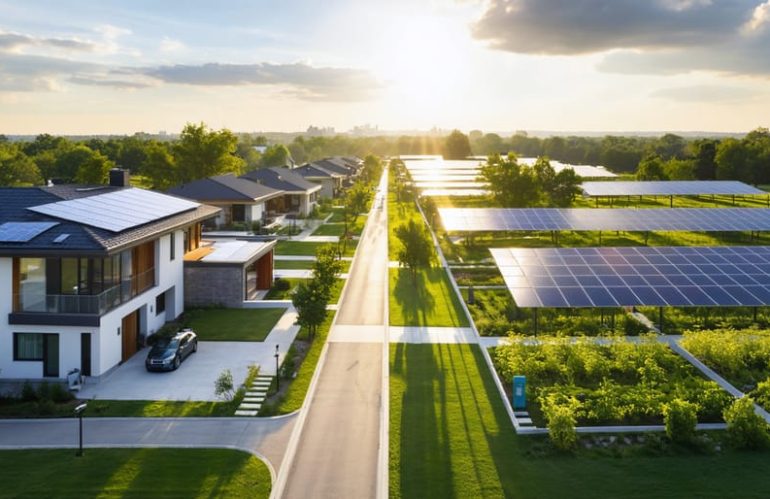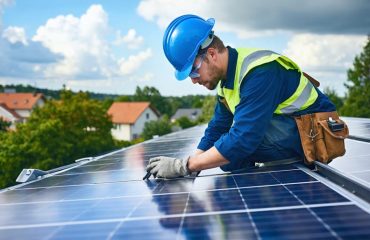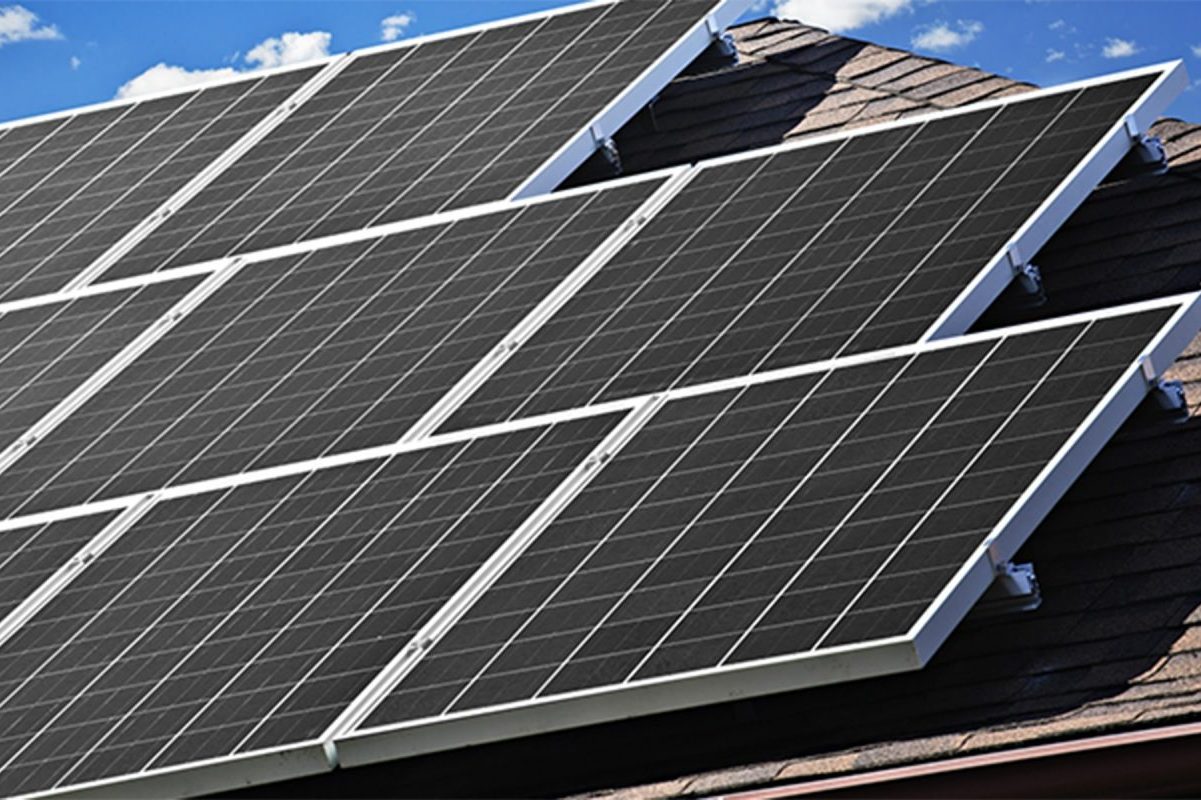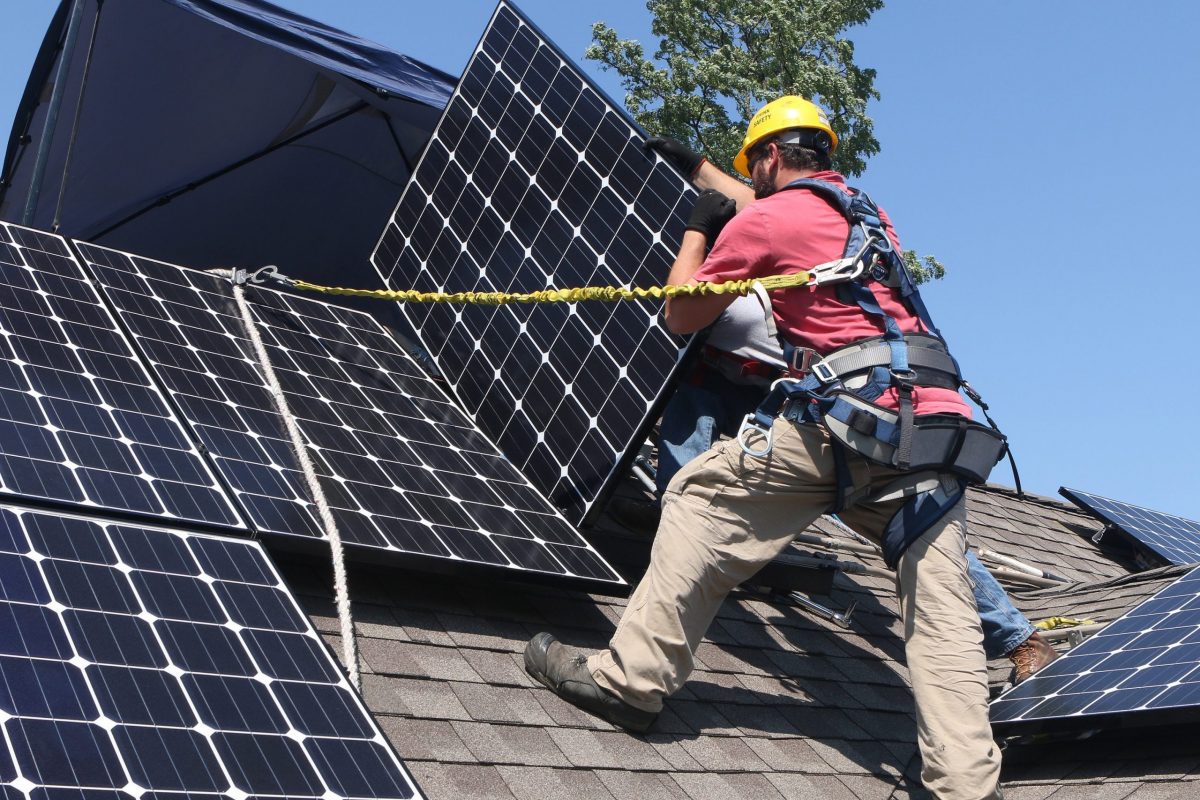As homeowners across America embrace solar energy, a crucial decision emerges: choosing between community solar projects and rooftop installations. While both options advance clean energy adoption, they serve distinctly different needs and situations. Community solar enables groups of residents to share the benefits of a large solar array, often located off-site, without installing panels on their properties. Meanwhile, rooftop solar provides individual homeowners with direct control over their energy production through panels installed on their own homes.
This rising popularity isn’t coincidental – solar installations have become 70% more affordable over the past decade, making both options increasingly accessible to average households. Whether you’re a homeowner with an ideal south-facing roof or an apartment dweller looking to reduce your carbon footprint, understanding these two approaches to solar energy is crucial for making an informed decision about your energy future.
Today’s solar landscape offers unprecedented flexibility in how we can participate in the clean energy revolution. As we explore the unique advantages and considerations of both community and rooftop solar systems, you’ll discover which option aligns best with your specific circumstances, energy goals, and financial objectives.
Understanding Community Solar Networks
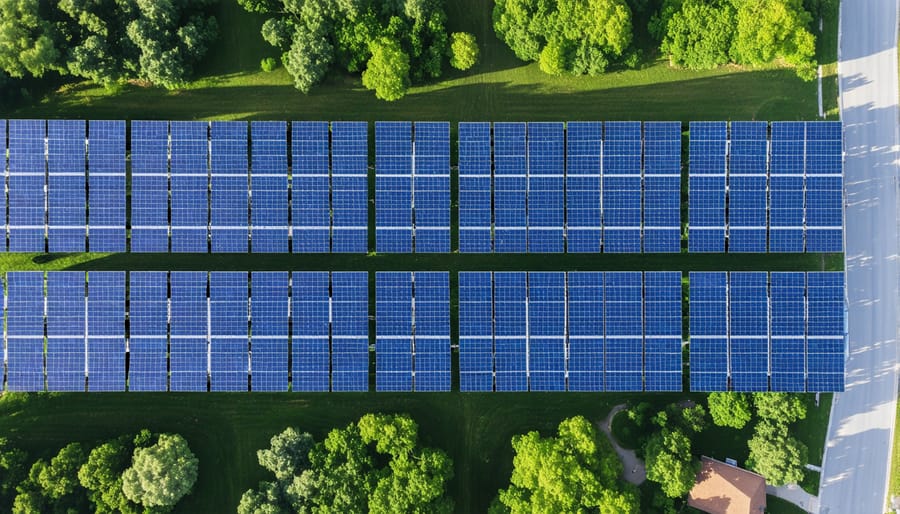
How Community Solar Works
Community solar works by allowing multiple households to share the benefits of a single, large-scale solar installation. Instead of installing panels on your roof, you subscribe to a portion of a solar farm’s output, typically located within your utility’s service area. Think of it like a community garden, but for solar energy.
When you join a community solar project, you’ll select a subscription size based on your electricity usage. The solar farm generates clean energy that feeds into the local power grid, and subscribers receive credits on their monthly utility bills proportional to their share of the project’s output.
The subscription model usually involves no upfront costs. You’ll pay a monthly fee for your share, which is typically 5-15% lower than your regular utility rates. Most programs operate through virtual net metering, where your portion of the solar generation is calculated and credited directly to your bill.
The infrastructure is professionally maintained by the project operator, eliminating maintenance concerns for subscribers. Contracts are flexible, often allowing you to transfer or cancel your subscription if you move, making it an accessible option for renters and homeowners alike.
The Social Benefits of Shared Solar
Community solar projects create more than just renewable energy – they build stronger neighborhoods and amplify environmental impact through collective action. When neighbors participate in solar communities, they develop shared goals and foster meaningful connections while working together toward sustainability.
These projects often spark wider community engagement, with participants organizing educational events, sharing energy-saving tips, and collaborating on other green initiatives. The visible presence of solar installations serves as a conversation starter, raising awareness about renewable energy and inspiring others to join the clean energy movement.
The collective environmental impact is significant – a single community solar garden can offset thousands of tons of carbon emissions annually, equivalent to taking hundreds of cars off the road. This shared achievement creates a sense of pride and accomplishment among participants, strengthening community bonds.
Additionally, community solar projects often include local job creation and workforce development programs, contributing to the area’s economic growth while building expertise in renewable energy technologies. This combination of social, environmental, and economic benefits makes shared solar a powerful catalyst for positive community change.
The Power of Personal Rooftop Solar
Direct Ownership Advantages
When you own your rooftop solar system, you gain complete control over your energy production and unlock several exclusive benefits. One of the most significant advantages is the potential increase in your property value – homes with solar installations typically sell for 4.1% more than those without. Making solar work for your home through direct ownership means you can customize the system to match your exact energy needs and aesthetic preferences.
Direct ownership also allows you to take full advantage of available tax incentives and rebates, which can significantly reduce your initial investment. You’ll enjoy complete independence in system maintenance decisions and have the freedom to upgrade your installation as technology improves. The energy savings start immediately, and once the system is paid off, you’ll essentially have free electricity for the remainder of the system’s life – typically 25-30 years.
Moreover, owning your solar system provides a sense of energy independence and environmental stewardship that many homeowners find deeply satisfying. You can monitor your production in real-time and make adjustments to maximize your energy efficiency.
Individual Energy Independence
Rooftop solar installations offer homeowners a unique opportunity to take control of their energy production and consumption. When you install solar panels on your property, you become your own power producer, giving you direct oversight of your electricity generation and usage patterns. This level of independence allows you to reduce reliance on the traditional power grid and protect yourself against rising utility costs.
With rooftop solar, you can monitor your energy production in real-time and make immediate adjustments to maximize efficiency. The system is entirely yours to manage, from maintenance decisions to potential upgrades. This autonomy extends to financial benefits as well – you’ll receive direct credits on your utility bills and can potentially earn income from excess energy production through net metering programs.
While community solar provides clean energy benefits, it doesn’t offer the same level of individual control. Your energy production is pooled with other participants, and you’re still dependent on the community solar farm’s management for system maintenance and operations. However, both options contribute to energy independence from fossil fuels and represent significant steps toward a more sustainable future.
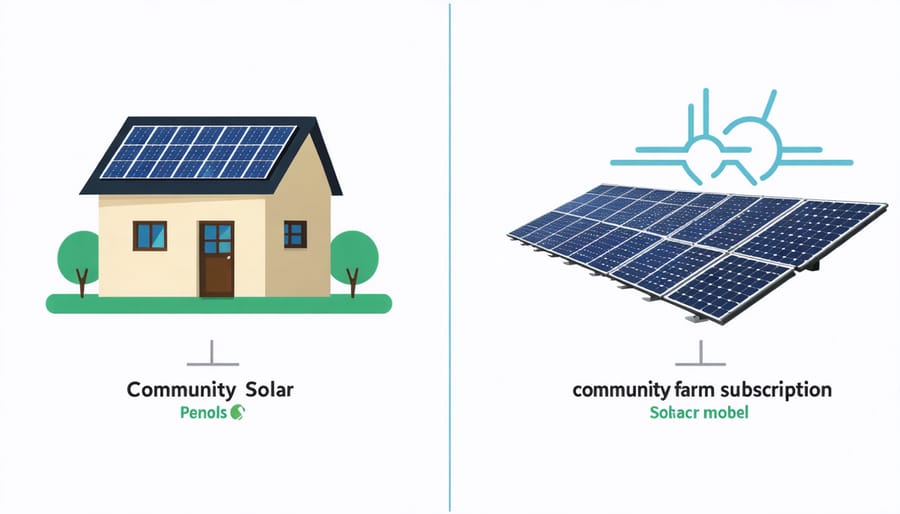
Cost Comparison: Community vs Rooftop Solar
Initial Investment Requirements
When comparing community solar and rooftop solar, initial investment requirements differ significantly. Rooftop solar typically requires a substantial upfront investment, ranging from $15,000 to $25,000 for an average home installation. This cost covers equipment, installation, and necessary permits. However, various financing options like solar loans, leases, and power purchase agreements (PPAs) can make rooftop solar more accessible.
Community solar, on the other hand, usually requires little to no upfront investment. Subscribers typically pay a monthly fee based on their energy allocation, similar to a regular utility bill. Some programs may require a small enrollment fee or deposit, but it’s considerably lower than rooftop installation costs. This makes community solar particularly attractive for renters, those with limited savings, or homeowners whose properties aren’t suitable for solar panels.
Both options offer financial incentives. Rooftop solar owners can benefit from federal tax credits, state rebates, and potential increases in property value. Community solar subscribers often enjoy immediate bill credits and guaranteed savings on their energy costs, typically ranging from 5% to 15% off standard utility rates.
Financing options for rooftop solar have become increasingly flexible, with many installers offering zero-down payment plans. Similarly, community solar programs often feature flexible subscription terms, allowing participants to cancel or transfer their subscription if they move within the service area.
Long-term Financial Benefits
When comparing the long-term financial benefits of community and rooftop solar, several key factors come into play. Both options offer substantial energy savings over time, but their return on investment (ROI) patterns differ significantly.
Rooftop solar typically provides a more direct financial return, with homeowners seeing immediate reductions in their monthly electricity bills. The average payback period ranges from 5-10 years, after which the energy generated is essentially free. Modern smart solar solutions also increase home value by 3-4% on average.
Community solar, while requiring less upfront investment, often delivers savings through credits on utility bills. These projects typically offer a 10-15% reduction in annual electricity costs. The subscription-based model eliminates maintenance concerns, as upkeep costs are shared among participants and handled by the project operator.
Maintenance costs vary significantly between the two options. Rooftop solar owners are responsible for panel cleaning, repairs, and occasional inverter replacement, which can cost between $300-1,000 annually. Community solar subscribers face no direct maintenance expenses, making it a more predictable investment over time.
Both options protect against rising energy costs, but rooftop solar provides greater independence from utility rate increases. While community solar offers lower initial costs and maintenance-free operation, rooftop installations generally deliver higher lifetime savings for those who can make the upfront investment.
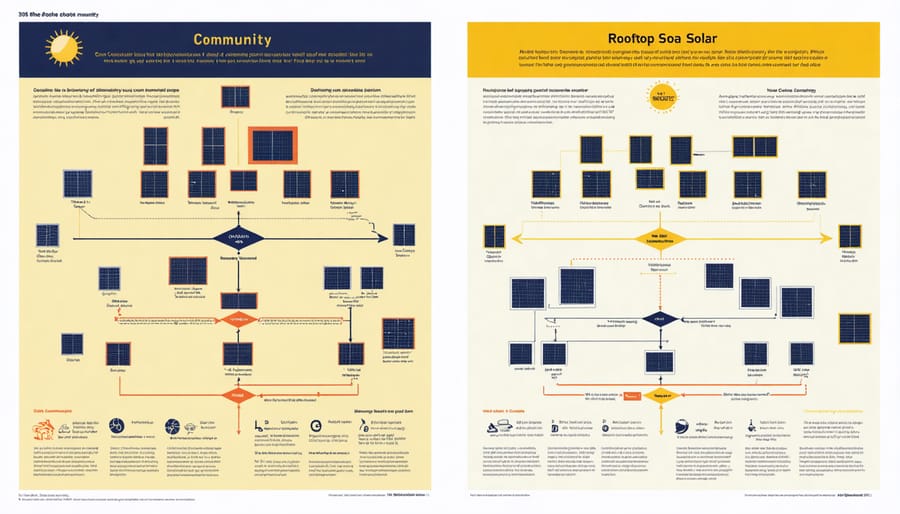
Making the Right Choice for Your Situation
Property Considerations
Before diving into understanding your solar options, it’s essential to evaluate several key property factors that will influence your decision between community and rooftop solar.
For rooftop solar, your roof’s condition, age, and structural integrity are crucial considerations. An ideal roof should be less than 10 years old, free from damage, and capable of supporting the additional weight of solar panels. The roof’s orientation and pitch also matter significantly, with south-facing roofs at a 30-45 degree angle typically offering optimal sun exposure.
Shade from nearby trees, buildings, or other structures can significantly impact rooftop solar efficiency. A professional solar assessment can determine if your roof receives enough direct sunlight throughout the day to make rooftop panels worthwhile.
Property ownership is another vital factor. Homeowners have the freedom to install rooftop systems, while renters or condo owners may face restrictions. This is where community solar shines as an alternative, requiring no physical modifications to your property.
For those with historic homes or properties subject to homeowners’ association (HOA) regulations, community solar can bypass potential installation restrictions or aesthetic concerns. Additionally, if you’re planning to move within the next few years, community solar offers more flexibility than a permanent rooftop installation.
Lifestyle and Community Factors
When choosing between community solar and rooftop solar, lifestyle factors and community dynamics play a crucial role in the decision-making process. Rooftop solar offers homeowners direct control over their energy system and often becomes a visible statement of environmental commitment. This option particularly appeals to those who plan to stay in their current home long-term and want to increase their property value.
Community solar, on the other hand, fosters a sense of collective environmental action and social connection. Participants often report feeling more engaged with their community through shared sustainable initiatives. This option proves especially attractive for renters, those living in apartments, or homeowners whose properties aren’t ideal for solar panels.
Your long-term plans should influence your choice. If you’re considering moving within the next few years, community solar offers more flexibility since subscriptions can often be transferred or canceled. Rooftop solar requires a longer-term commitment to realize the full financial benefits, though it can add significant value during home resale.
Community involvement levels also differ between options. Rooftop solar is largely an individual endeavor, while community solar projects often include regular updates, educational events, and opportunities to connect with fellow subscribers. This social aspect can be particularly rewarding for those who value community engagement and collective environmental action.
Whether you choose community solar or rooftop solar, you’re making a positive impact on both the environment and your energy costs. Both options offer unique advantages that can suit different lifestyles and living situations. Rooftop solar provides direct ownership and maximum energy independence, while community solar offers flexibility and accessibility without the need for installation or maintenance.
Consider your specific circumstances when making your decision. If you own your home, have a suitable roof, and plan to stay there long-term, rooftop solar might be your best choice. On the other hand, if you rent, live in a multi-unit building, or prefer a low-commitment option, community solar could be the perfect solution.
The solar industry continues to evolve, with improving technology and decreasing costs making both options increasingly attractive. Don’t let analysis paralysis hold you back – the most important step is taking action. Start by getting quotes from local solar installers or researching community solar projects in your area. Many state and federal incentives are available now, making this an ideal time to embrace solar energy.
Remember, whether you choose community or rooftop solar, you’re joining a growing movement of environmentally conscious consumers who are helping to create a more sustainable future while saving money on their energy bills. Take the first step today toward your solar journey – your wallet and the planet will thank you.

